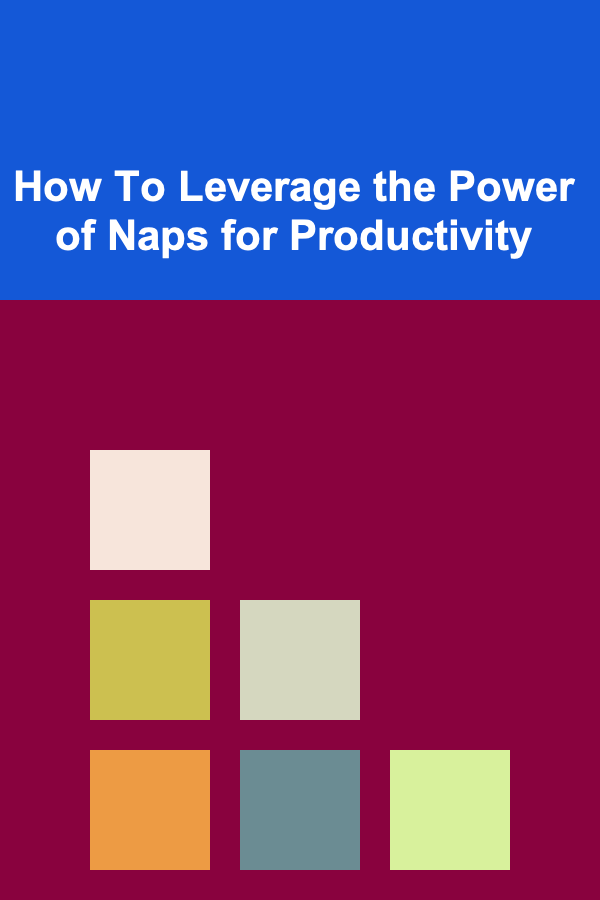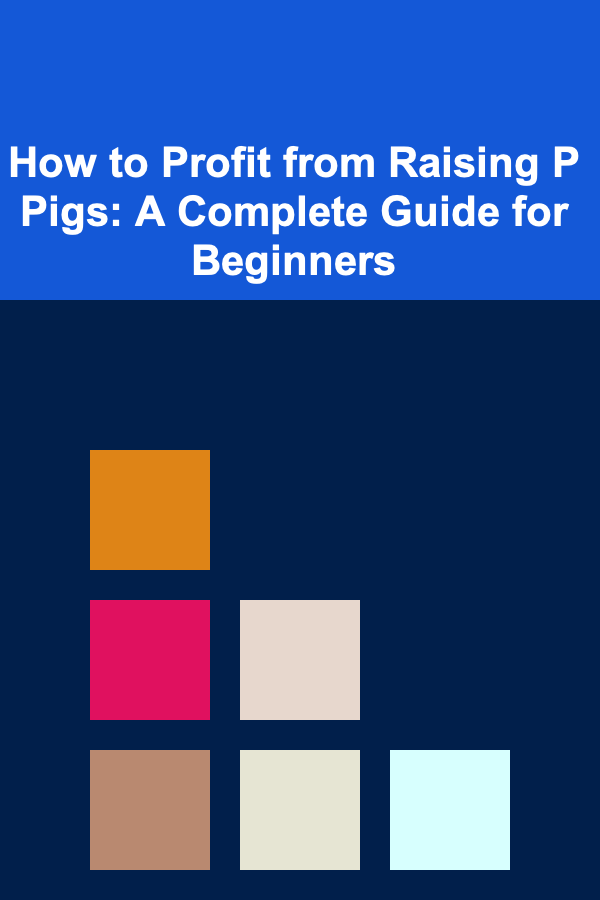
How To Leverage the Power of Naps for Productivity
ebook include PDF & Audio bundle (Micro Guide)
$12.99$5.99
Limited Time Offer! Order within the next:

In today's fast-paced world, productivity is often equated with long working hours, endless to-do lists, and a constant sense of urgency. However, amidst the hustle, an unlikely hero is often overlooked: naps. Yes, the simple act of taking a nap can significantly boost productivity, enhance cognitive performance, and improve overall well-being.
Despite the common misconception that naps are a sign of laziness or a waste of time, research consistently shows that strategic naps can be a powerful tool for improving mental and physical health. In this article, we will explore how naps can be used effectively to maximize productivity, how to take the perfect nap, and the science behind why naps work.
The Science Behind Naps
Before diving into the specifics of how to leverage naps for productivity, it's essential to understand the science behind them. Napping isn't merely an indulgence or a luxury; it plays a critical role in how our brains function.
When we sleep, our brains undergo essential processes that support memory consolidation, learning, and emotional regulation. But sleep is not just one continuous block; it's made up of various stages, each contributing to different aspects of cognitive function.
- Non-Rapid Eye Movement (NREM) Sleep: This stage is essential for physical restoration, healing, and immune system boosting. NREM sleep is divided into three stages, with deeper stages promoting restorative functions, including muscle repair and growth.
- Rapid Eye Movement (REM) Sleep: REM sleep is critical for cognitive functions like memory consolidation, problem-solving, and emotional processing. It's during this phase that the brain integrates newly learned information and experiences.
When we nap, we typically go through a lighter version of these sleep stages, although the depth of the stages depends on how long the nap lasts. In short, naps offer a mini recharge for the brain, allowing it to restore, consolidate memories, and prepare for the next phase of productivity.
Benefits of Napping for Productivity
While sleep is important for everyone, naps provide unique advantages that can directly influence productivity. Below are some of the key benefits of napping:
1. Improved Cognitive Performance
Research has consistently shown that napping can lead to sharper focus, better memory retention, and enhanced creativity. A study conducted by NASA found that short naps could improve cognitive performance in pilots and astronauts, making them more alert and focused. Napping enhances the ability to concentrate, which means that even a 20-minute nap can help you come back to work with increased attention and improved problem-solving skills.
2. Enhanced Memory Consolidation
Naps are crucial for the consolidation of new information. During a nap, the brain strengthens connections between neurons, making newly learned information easier to recall. If you've been studying or working on a challenging task, a nap can help "lock in" the details, improving your ability to remember and apply the information later.
3. Better Emotional Regulation
Naps can help restore emotional balance by improving mood and reducing irritability. When we are sleep-deprived, our brains are less able to regulate emotions effectively, leading to heightened stress and negative feelings. A well-timed nap can alleviate anxiety, reduce feelings of frustration, and bring a sense of emotional calm, making it easier to handle difficult tasks and interpersonal interactions.
4. Increased Alertness and Reduced Fatigue
Fatigue can be a significant barrier to productivity. After a long morning of work, our energy levels tend to dip, making it harder to focus and complete tasks efficiently. Taking a short nap during the afternoon helps to alleviate this dip in energy, making it easier to power through the remainder of the day. Napping has been shown to increase alertness, reduce the likelihood of making mistakes, and improve overall task performance.
5. Boosted Creativity
One of the lesser-known benefits of napping is its ability to boost creativity. Research suggests that naps, particularly those that include REM sleep, encourage the brain to make novel connections between unrelated ideas. Whether you're brainstorming for a new project or trying to find innovative solutions to a problem, a nap might just be the key to unlocking your creative potential.
6. Health Benefits
Napping can also have long-term health benefits that indirectly improve productivity. Studies have shown that regular napping reduces the risk of heart disease, lowers blood pressure, and improves overall well-being. When you're healthier, you're naturally more productive, as you have more energy and less stress to contend with.
How to Take the Perfect Nap
Now that we understand the benefits of napping, let's explore how to take the perfect nap to maximize these benefits. Not all naps are created equal, and the timing, duration, and environment of your nap can make a significant difference in how well-rested and productive you feel afterward.
1. Timing Your Nap
Timing is crucial when it comes to napping. Taking a nap too late in the day can interfere with your nighttime sleep and lead to feelings of grogginess. Ideally, naps should be taken between 1:00 PM and 3:00 PM, as this is when the body's energy levels naturally dip. This is often referred to as the "afternoon slump." Napping during this time helps you avoid the worst of fatigue and prepares you for a productive evening.
2. Keep It Short
One of the most important aspects of napping for productivity is duration . While a long nap might feel tempting, it's often counterproductive. A nap that lasts between 10 to 30 minutes is ideal for boosting productivity.
- 10-20 minutes: This is a power nap, and it's the sweet spot for feeling refreshed and energized. In this short window, you only enter light NREM sleep, which is enough to enhance alertness and cognitive performance without leaving you feeling groggy.
- 30 minutes: A nap of this length might take you deeper into NREM sleep, but you're likely to wake up feeling a little disoriented or groggy. If you want to experience the benefits of a nap without the grogginess, aim for 10-20 minutes instead.
- 60 minutes: A one-hour nap may allow you to enter deeper stages of NREM sleep, which helps with memory consolidation. However, waking up from this stage can lead to sleep inertia, the grogginess that you feel when you wake up from deep sleep. It's a good option if you need to enhance memory but can handle a bit of disorientation.
- 90 minutes: This is a full sleep cycle, and a nap of this length allows your body to go through both NREM and REM sleep. If you have the time and want to wake up feeling rested without the grogginess, this is the ideal duration. A 90-minute nap can also improve creativity and problem-solving skills.
3. Create the Right Environment
To maximize the benefits of your nap, ensure that the environment is conducive to sleep. This means minimizing distractions and creating a comfortable space. Consider the following:
- Dim the lights: A dark environment signals to your brain that it's time to rest.
- Quiet surroundings: If possible, find a quiet space or use earplugs or noise-canceling headphones to block out noise.
- Comfortable setting: Lie down if you can, or recline in a comfortable chair to fully relax.
- Cool temperature: A cooler room temperature can help you fall asleep faster and enhance sleep quality.
4. Use Relaxation Techniques
If you find it difficult to fall asleep during a nap, try incorporating relaxation techniques such as deep breathing, progressive muscle relaxation, or visualization. These methods can help calm your mind and prepare your body for rest, even in the middle of a busy day.
5. Avoid Caffeine Before Napping
Caffeine is a stimulant that can interfere with your ability to fall asleep, even for a short nap. If you plan on napping, avoid consuming caffeine for at least 4-6 hours before your nap. This will help ensure that your nap is restorative and doesn't interfere with your ability to relax.
Naps and Different Work Environments
While napping is often associated with home or personal time, its benefits extend to the workplace as well. Many forward-thinking companies are starting to recognize the value of naps and are integrating them into their office cultures.
1. Corporate Workplaces
Some companies are investing in nap pods or quiet rooms where employees can take a brief rest during the day. These initiatives not only show that the company values employee well-being but also lead to a more productive workforce. Studies have shown that employees who take naps during the day experience improved focus, better decision-making skills, and a greater sense of satisfaction with their work.
2. Freelancers and Remote Workers
For those working from home or as freelancers, it's important to remember that napping can be a strategic tool, not just a lazy indulgence. Setting aside time for a nap during the workday can help overcome afternoon fatigue and keep your productivity high throughout the day.
If you're working remotely, set boundaries by scheduling naps and sticking to the time limit to ensure that naps enhance your workflow rather than disrupt it.
Conclusion
Napping is not just for children or the elderly---it's an effective strategy that can enhance productivity, improve mental health, and increase energy levels for anyone. By understanding the science behind naps, timing your naps effectively, and creating the right environment, you can use naps to maximize your cognitive abilities and fuel your success.
Incorporating naps into your routine is not about being lazy; it's about recognizing the importance of rest for overall productivity. A short, strategic nap can make all the difference in achieving your goals, improving focus, and maintaining energy levels throughout the day. So, the next time you feel your productivity slipping, consider taking a nap---it might just be the reset you need to power through the rest of the day.

How to Create a Fun DIY Photo Booth for Your Party
Read More
How to Create a Home Budget That Works for Your Unique Lifestyle
Read More
How to Create a Relaxing Atmosphere for a Dinner Party
Read More
How to Profit from Raising P Pigs: A Complete Guide for Beginners
Read More
How to Grasp the Concepts of Transcription and Translation
Read More
How to Identify and Address Emotional Neglect: A Psychologist's Advice
Read MoreOther Products

How to Create a Fun DIY Photo Booth for Your Party
Read More
How to Create a Home Budget That Works for Your Unique Lifestyle
Read More
How to Create a Relaxing Atmosphere for a Dinner Party
Read More
How to Profit from Raising P Pigs: A Complete Guide for Beginners
Read More
How to Grasp the Concepts of Transcription and Translation
Read More